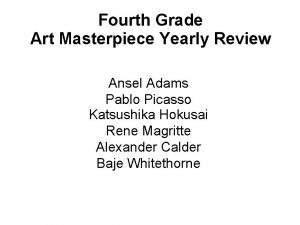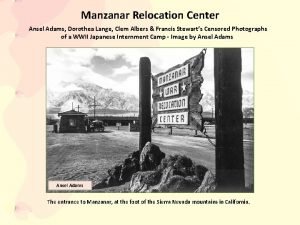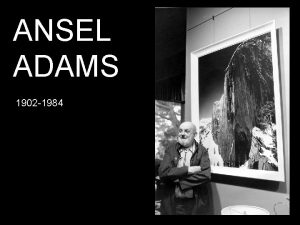Method and Art of Ansel Adams ARHI 198






















- Slides: 22

Method and Art of Ansel Adams ARHI 198 Directed Reading Professor Tad Beckman Gautam Thatte, 11/22/2002

Overview n n n How and when was Ansel Adams introduced to photography? The shift from pictorialism to modernism What was Group f/64? Technical Legacy of Ansel Adams Examining some photographs

Introduction to Photography n n Was first introduced to it in the 1915 San Francisco Panama Pacific Int’l Exposition Took pictures of Yosemite on his first trip there using his Kodak #1 Box Brownie Part-time work with a photo-finisher for two winters comprised his photographic schooling In 1921, some of his photos were published in a Yosemite magazine and even sold there

n n Adams gave up the pictorialist approach by 1925, and in the spring of 1926, met an ardent patron in Albert Bender In 1927, Adams published his first portfolio, Parmelian Prints of the High Sierras

Why black and white photography? n n n He never processed his color films or made his own color prints “Rarely would an image fit the camera format so perfectly that Adams felt no change was necessary” About In Color, colleague Al Weber remarked only twelve out of fifty prints, over forty years, warranted printing

Pictorialism to Modernism Hand of Man (Stieglitz, 1902) Wheels (Sheeler, 1939)

Influencing Factors n n Visited the artist colonies in Santa Fe and Taos in the late 1920 s Stieglitz and Steichen introduced modern European art as early as 1909 Cubism was an important influence; it was being better understood and mimicked through the photographic medium. This geometric influence yielded machinery and city architecture, and numerous close-ups and severely cropped views. - Rosenblum

n n n Met Paul Strand in Taos. He showed Adams his negatives and this “caused Adams to finally commit to photography as a career” Also met John Marin and Georgia O’Keefe in Taos and inherited the idea of using indigenous American elements as subjects Edward Weston converted to straight photography years before Adams did; his works were an inspiration, but his vegetables seem contrived until Adams photographed Rose and Driftwood

Group f/64 n n Forming Group f/64 was the idea of Willard Van Dyke and Preston Holder Saw that their colleagues better understood the modernist principles through their art; Ansel in the Sierras, Imogen Cunningham’s plant and nude forms, and their belief that Weston’s work was superior to that of Strand

Pure photography did not mean no manipulation; it was agreed that negatives and prints could be manipulated as long as a prescribed list of techniques considered to be photographic in nature was used. The choice of lens could alter spatial relations and relative scale. The tonal contrast of the negative could be enhanced or diminished during development. Dodging and burning during the printing of the image could lighten or darken specific areas of the photograph. But all of these techniques could be used only to a limited degree, so that they did not interfere with the essence of the reality of the scene before the photographer. The Group f/64 Manifesto


Did Adams photograph only landscapes? n n n Rose and Driftwood and other portraits Commercial assignments for Polaroid and United States Potash Documentary photography including the Manzanar relocation camps, and Three Mormon Towns

Technical Legacy of Adams n n n Explained visualization, the zone system (with Fred Archer) and printing Attempted to make his photographs and his teaching available Books included Making a Photograph, the Basic Photo Series and Examples: The Making of 40 Photographs

Visualization n The conscious process of projecting the final photographic image in the mind before taking the first steps in actually photographing the subject Adams recognized that visualization is not arcane and is intuitive for many people, and wrote the Basic Photo Series to refine the process for those who were familiar with it, and to assist those individuals who strive to create aesthetically pleasing photographs Requires technical knowledge of all the resources available when taking the photograph; lenses, filters, light meters etc

The Zone System n n n The Zone System divides the range of tones produced by a printing paper into ten zones ranging from Zone 0 (pure black) to Zone IX (pure white), with Zone V representing middle gray Assists in deciding which elements of a photograph should consist of detail Representation of a wider range of zones is high-contrast http: //www. sentex. net/~sfinlay/technique 1. htm

Aspens Northern New Mexico, 1958 An excellent example of representing every zone

Printing Process n n n Had an excellent mastery over the technical aspects of photography He experimented with various papers, and development techniques from the very beginning Believed that photographs should be reproducible and at the same quality

Photographs of Ansel Adams “ Moonrise represents the product of a series of conscious interpretive decisions by the photographer, not simply the record of a beautiful scene. At each stage of the process, Adams applied his technical mastery of the medium to create an image that would convey the emotions he felt. ” Jonathan Spaulding

Monolith, The Face of Half Dome n n Image was Adams’ first conscious visualization Knew after the first exposure that the effect he wanted would be achieved by using a red filter

Moonrise, Hernandez n n Most popular image Could not find his Weston exposure meter! Resulted in only one negative Did not accurately date this photograph

Mount Williamson, Manzanar n n n Site of the Manzanar Relocation Camp Was a very highcontrast image and printing was rather difficult at first Is this a real photo?

References n Alinder, Mary Street. Ansel Adams, A Biography n n Spaulding, Jonathan. Ansel Adams and the American Landscape Seeing Straight: f. 64. Essays by Naomi Rosenblum and Therese Thau Heyman
 And i shall
And i shall Gary ansel
Gary ansel Adams and adams secretarial training
Adams and adams secretarial training Solar year 198
Solar year 198 Nyc doe op198
Nyc doe op198 Ley 198
Ley 198 Achei um bom amigo - harpa número
Achei um bom amigo - harpa número A rescue plane flies at 198 km/h
A rescue plane flies at 198 km/h Bill 198 sox
Bill 198 sox Electron configuration
Electron configuration Como encontrar el mcd
Como encontrar el mcd Au-197=50 au 198=50
Au-197=50 au 198=50 Tentukan faktorisasi prima dari 252
Tentukan faktorisasi prima dari 252 A rescue plane flies at 198 km/h
A rescue plane flies at 198 km/h Cets 198
Cets 198 Recomendacion 198
Recomendacion 198 198+14
198+14 21cfr820.198
21cfr820.198 Le duet 198
Le duet 198 198 2
198 2 Purpose of symposium
Purpose of symposium Non traditional art
Non traditional art Cultural formulae
Cultural formulae










































